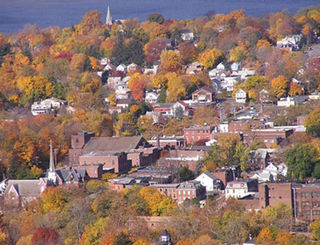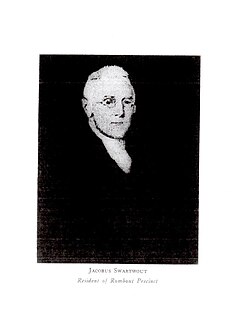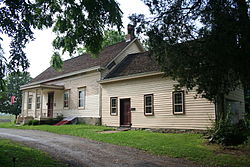
Dutchess County is a county in the U.S. state of New York. As of the 2020 census, the population was 295,911. The county seat is the city of Poughkeepsie. The county was created in 1683, one of New York's first twelve counties, and later organized in 1713. It is located in the Mid-Hudson Region of the Hudson Valley, north of New York City.

Beacon is a city located in Dutchess County, New York, United States. The 2020 census placed the city total population at 13,769. Beacon is part of the Poughkeepsie–Newburgh–Middletown, New York Metropolitan Statistical Area as well as the larger New York–Newark–Bridgeport, New York–New Jersey–Connecticut–Pennsylvania Combined Statistical Area.

Wappinger, officially the Town of Wappinger, is a town in Dutchess County, New York, United States. The town is located in the Hudson River Valley region, approximately 60 miles (97 km) north of Midtown Manhattan, on the eastern bank of the Hudson River. The population was 28,216 at the 2020 census. The name is derived from the Wappinger Native Americans who inhabited the area. Wappinger comprises three-fourths of the incorporated Village of Wappingers Falls, several unincorporated hamlets such as Chelsea, Diddell, Hughsonville, Middlebush, Myers Corners, New Hackensack, and Swartwoutville, and a number of neighborhoods.

Wappingers Falls is a village in Dutchess County, New York, United States. As of the 2010 census it had a population of 5,522. The community was named for the cascade in Wappinger Creek. The Wappingers Falls post office covers areas in the towns of Wappinger, Poughkeepsie, Fishkill, East Fishkill, and LaGrange. This can result in some confusion when residents of the outlying towns, who do not live in the village, give their address as "Wappingers Falls".

Fishkill is a village within the town of Fishkill in Dutchess County, New York, United States. The village population was 2,171 at the 2010 census. It is part of the Poughkeepsie–Newburgh–Middletown, NY Metropolitan Statistical Area as well as the larger New York–Newark–Bridgeport, NY-NJ-CT-PA Combined Statistical Area.

Fishkill is a town in the southwestern part of Dutchess County, New York, United States. It lies approximately 60 miles (97 km) north of New York City. The population was 22,107 at the 2010 census. Fishkill surrounds the city of Beacon, and contains a village, which is also named Fishkill.

Washington's Headquarters State Historic Site, also called Hasbrouck House, is located in Newburgh, New York overlooking the Hudson River. George Washington lived there while he was in command of the Continental Army during the final year of the American Revolutionary War; it had the longest tenure as his headquarters of any place he had used.

Fishkill Creek is a tributary of the Hudson River in Dutchess County, New York, United States. At 33.5 miles (53.9 km) it is the second longest stream in the county, after Wappinger Creek. It rises in the town of Union Vale and flows generally southwest to a small estuary on the Hudson just south of Beacon. Part of its 193-square-mile (500 km2) watershed is in Putnam County to the south. Sprout Creek, the county's third-longest creek, is its most significant tributary. Whaley and Sylvan lakes and Beacon Reservoir, its largest, deepest and highest lakes, are among the bodies of water within the watershed.

The Madam Brett Homestead is an early 18th-century home located in the city of Beacon, New York, United States. It is the oldest standing building in its part of Dutchess County and has been listed in the National Register of Historic Places since 1976. It is also listed on the NYS Independence Trail.

Mount Gulian is a reconstructed 18th century Dutch manor house on the Hudson River in the town of Fishkill, New York, United States of America. The original house served as the headquarters of Major General Friedrich Wilhelm von Steuben during the American Revolutionary War and was the place where the Society of the Cincinnati was founded. The site is registered as a National Historic Landmark.

Dutchess Mall was an enclosed shopping mall in Fishkill, New York. The mall was demolished and replaced with a Home Depot except for the Jamesway and Service Merchandise buildings. The former Service Merchandise building was home to a flea market until the mid-2000s but now sits vacant and empty. At some point in the mid-2000s, the Dutchess Marketplace Flea Market move to the former Jamesway building, although it closed at the end of 2019. A new campus for Dutchess Community College moved into the Jamesway space and opened in August 2021. Dagar Group manages the shopping area. R.C. Chera Realty Group is the exclusive leasing broker for the existing vacant structure.

The U.S. Post Office in Beacon, New York, is located on Main Street. It serves the ZIP Code 12508, covering the entire city of Beacon and some of the neighboring areas of the Town of Fishkill. It is a stone structure in the Dutch Colonial Revival architectural style built in the mid-1930s. In 1988 it was listed on the National Register of Historic Places along with many other older post offices in the state.

The Clinton House is an 18th-century Georgian stone building in the city of Poughkeepsie, Dutchess County, New York, United States. It is a New York State Historic Site and has been listed in the National Register of Historic Places as a historic place of local significance since 1982. The house was named for George Clinton, who served as the first Governor of New York and fourth Vice-President of the United States. He was believed to have lived there after the American Revolutionary War, but it is now known that it was never his residence.

The Glebe House is an 18th-century Georgian brick building in Poughkeepsie, Dutchess County, New York, USA. It is listed in the National Register of Historic Places as a historic place of local significance since 1982.

The Wappingers Falls Historic District is in the center of that village in Dutchess County, New York, United States. It is a 90-acre area roughly centered along South Avenue and West Main Street, NY 9D and Wappinger Creek. It includes Mesier Park in the center of the village and many adjacent residential neighborhoods, roughly bounded by Elm, Park, Walker, Market and McKinley streets.

The John Kane House, also one of several places known as Washington's Headquarters, is located on East Main Street in Pawling, New York, United States. Built in the mid-18th century, it was home during that time to two men who confronted the authorities and were punished for it. During the Revolutionary War, George Washington used the house as his headquarters when the Continental Army was garrisoned in the area.

The Storm–Adriance–Brinckerhoff House is located on Beekman Road in East Fishkill, New York, United States. It is a wooden building in three parts, the oldest of which dates to the mid-18th century.

Jacobus Swartwout (1734–1827) was an early American landowner, statesman, and military leader. Swartwout served as a Brigadier General in the Continental Army during the American Revolutionary War under General George Washington. He was a close ally of many key Founding Fathers of the United States, and a delegate to New York State's convention for ratification of the US Constitution.

Denise Doring VanBuren was elected the 45th President General of the National Society Daughters of the American Revolution in June 2019, a three-year term.
Dirck Brinckerhoff or Derick Brinkerhoff was an American soldier who fought in the Revolutionary War and politician who served in both the New York General Assembly and the New York State Assembly.




















